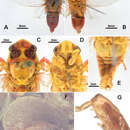Description
provided by Zookeys
Head (Fig. 10A–B) mostly pale yellow, with reddish markings on vertex; clypeus yellow and depressed; ocellus orange, eye castaneous, distance between lateral ocellus and corresponding eye about as long as distance between lateral ocelli; face and gena yellow; rostrum yellowish with apical half light brown, extending to apex of mid coxae.
Pronotum (Fig. 10C) with central longitudinal yellowish fascia well broadened at both anterior and posterior parts; symmetrically with two large reddish brown to dark brown patches with border black; pronotal collar mostly reddish with lateral part pale yellow. Mesonotum (Fig. 10C) mostly yellowish, symmetrically tinged with red to reddish brown laterally in male but with blackish fasciae in female; cruciform elevation yellowish. Ventral surface of thorax mostly yellow, without distinct markings.
Legs (Fig. 10G) yellow except for reddish brown pretarsal claws; fore femur with primary spine long, digitate and slanted; secondary spine short, sharp and erect; subapical spine short, sharp and slanted.
Wings (Fig. 10A–B) hyaline, without any markings; veins in basal half reddish and yellowish apically.
Male abdomen (Fig. 10A–B) obconical, mostly dark red, with discontinuous central longitudinal yellowish fascia in dorsal view; timbal cover (Fig. 10F) ochreous; operculum (Fig. 10E) pale yellowish, obliquely ellipsoidal, subapical portion enlarged toward body center, extending slightly beyond posterior margin of abdominal sternite II, medial margins almost touching (holotype) or even touching (male paratype) each other. Female abdomen mostly black dorsally and yellowish brown ventrally, with discontinuous central longitudinal yellowish fascia in dorsal view, with reddish brown band on each posterior margin of terga 2–7; operculum small, semicircular, extending slightly beyond posterior margin of abdominal sternite II, both opercula well separated from each other.
Male genitalia (Fig. 11A–D). Pygofer oval in ventral view; dorsal beak long with obtuse tip; distal shoulder broadly convex in lateral view; upper lobe of pygofer remarkably long, digitate, curved inwardly. Uncus undeveloped in lateral view; apex of median lobe slightly produced, forming a small process curved upwards in ventral view. Clasper in ventral view with median clasper process well developed and twisted subbasally, forming a large process curved laterally; apex of median clasper process curved laterally and acute apically; lateral clasper lobe roundly developed inwards, partially overlapped by the large subapical process of median clasper process. Aedeagus with seven short to long processes apically and subapically, which are all pointed upward in ventral view but arranged into two groups in lateral view (three located ventrally and four dorsally). Posterior margin of sternite VII rounded.
Female pygofer (Fig. 12A–B) with dorsal beak short and acute; ovipositor short, not extending beyond the end of abdomen; posterior margin of sternite VII with median incision very broad and relatively shallow, deep to about 1/2 the length of sternite VII.
Measurement (2♂♂, 1♀) (in mm). Length of body: ♂20.0–21.0, ♀ 21.0; length of fore wing: ♂21.0, ♀ 25.5; width of fore wing: ♂7.0, ♀ 8.0; width of head including eyes: ♂6.0, ♀ 6.5; width of pronotum (including pronotal collar):♂ 7.0, ♀ 7.5; width of mesonotum:♂ 6.5, ♀ 7.0.
- license
- cc-by-3.0
- copyright
- Mingsheng Yang, Cong Wei
- bibliographic citation
- Yang M, Wei C (2013) On the cicada genus Nipponosemia Kato, with description of one new species from China (Hemiptera, Cicadidae) ZooKeys 293: 19–39
- author
- Mingsheng Yang
- author
- Cong Wei

